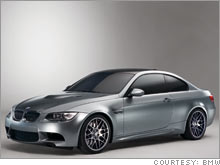The future of the automobileBMW's Chris Bangle has ideas about where new car designs are headed. An interview with Fortune's Alex Taylor.NEW YORK (Fortune) -- At the Geneva Auto Show, worries about carbon dioxide emissions and sustainability ran laps around such traditional topics as horsepower and performance. Automakers introduced a raft of vehicles that run on natural gas, batteries, biofuels and solar power. Said one analyst: "Everyone wants to be perceived as working on the problems of the environment." Watching the developments with unusual attentiveness was Chris Bangle, chief of design for BMW. Bangle is considered the most influential and far seeing designer in the world. Roundly criticized for his radical reworking of BMW's 7- and 5-series cars a few years ago (remember the "I hate Chris Bangle" Web site?), he has been thoroughly vindicated by other automakers. Features he pioneered like the short, high-deck trunk -- nicknamed the "Bangle Butt" -- have since been copied by Mercedes and Toyota (Charts).  Fortune's Alex Taylor III sat down with Bangle after the Geneva show to find out what the future of the automobile will look like. How will environmental concerns influence the car designs of the future? At the most fundamental level, sustainability is just a new problem to solve. I've lived under this before, whether it was the need to strengthen bumpers in the 70s, or improve aerodynamics in the '80s, or deal with pedestrian safety regulations today. For the most part, sustainability will be solved in ways that don't show up in the car design itself. It will be subtle under-the-skin differences in engines, and drivetrains, and technology. But if we believe that cars reflect their owner's personalities, then what we are seeing here is a shift in the value system for customers where they want to reflect these responsibilities. At the same time, they want it to be understood that it is still okay to drive cars that are sporty or fun. Cars with future-oriented themes that looked like something out of Buck Rogers were rejected by the public as not too desirable. And now that has been replaced by the phenomenon of cars that look intelligent but not particularly sexy. That doesn't include BMW, I presume. If you were handed a clean sheet of paper and asked to design a car without reference to 100 years of automotive tradition, how would it be different? Any time you see formality completely subjugated by functional concerns, it is usually a shock to the status quo. Just look at the difference between stealth airplanes and the previous generation. The old message that pretty planes fly faster didn't apply to the stealth because being faster isn't what stealth is all about. You can accept that mentally, but it had a shocking effect on people at the time. Over time what I feel is interesting is that they were able to evolve stealth airplanes that were really pretty, too. We are carrying around a lot of baggage as car designers in terms of brand awareness. If you start with a clean sheet of paper, you don't have that issue to deal with. You could do things that work aerodynamically that look stupid in our eyes because we're not accustomed to it. Manufacturers are experimenting with different body styles like sport wagons and tall hatches and other kinds of two-box designs that don't have a trunk. What do you think will be the most long-lasting? I think the durability of the sedan as well as its worldwide appeal argues well for it as a concept that resonates with people's ideas about how their lives are oriented. They understand the difference between an area for powertrain, an area for people, and an area for their stuff. When you mix those up too much, people don't understand what the message of the vehicle is. If you have a vehicle that equates people and stuff, like a two-volume hatchback generally does, then you are starting off with a different kind of appeal structure. I think that lies behind the [declining popularity of] minivans in America and why SUVs were the only ones of these large, two-volume vehicles accepted. With their understood four-wheel-driveness and ruggedness, they brought with them a different value scale. In Europe you would almost never have people with large amounts of income being happy with a two-volume vehicle like a hatchback or a minivan. They want to structurally show their societal position, which is why three volumes are so popular. They show 'I'm part of that hierarchy.' _____________________ |
|
